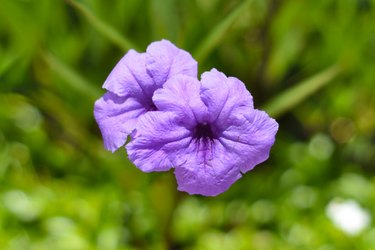
Although considered highly invasive in locations such as Florida, the one problem you won't have to worry about when growing Mexican petunias (Ruellia simplex, USDA zones 8 to 10) is a disease. These hardy free blooming perennials grow in a wealth of different conditions and will prove to be problem-free additions to your garden. Even black thumb gardeners will have success growing them.
Description and Notable Characteristics
Video of the Day
Mexican petunias also go by the common names Texas petunia and Mexican bluebells and also have several scientific names attached to them. Other than the current scientific name Ruellia simplex, Mexican petunia plants have also been classified under Ruellia brittoniana, Ruellia coerulea, Ruellia tweediana and Ruellia malacosperma according to the University of Georgia, but all refer to the same plant. They earn their common name because they are native to Mexico and the flowers resemble standard garden petunias (Petunia spp.).
Video of the Day
Although Mexican petunias perform as perennials within their hardiness zones, those living in cooler regions can grow them as annuals. The herbaceous perennial evergreen grows 2 to 4 feet tall with a spread of up to 3 feet, according to North Carolina State Extension. Tall woody-based stems are green to copperish-brown and covered in narrow 6- to 12-inch long willow-like leaves that are sometimes tinged in purple.
The purple trumpet-shaped flowers have a long bloom season, flowering from spring through fall making showy additions to the garden. Each loose flower cluster is filled with petunia-like blooms that only last for a single day. The spent flowers then develop into thin, 1-inch pods that explode spreading the tiny seeds in all directions and self-seeding throughout the landscape.
Mexican Petunia Potential Problems
The Mexican petunia plant isn't plagued by pest or disease problems making it a hardy and problem-free addition to gardens, according to Missouri Botanical Gardens. It won't be the fussy plant in your garden but might grow so well you'll find you're having problems getting its spreading growth under control. The biggest problem with growing Mexican petunias is its highly invasive nature, especially throughout its growing zones. Between its spreading rhizomes, exploding seeds readily self-seeding throughout areas and escaping from gardens, the plant has aggressively become naturalized in portions of the Southeast where it's hardy. The plant's seeds can remain for quite some time in the soil and both the seeds and the plant's rhizomes float in water, carrying the problem to additional areas for it to invade.
Even though Mexican petunias are attractive plants, especially when in bloom, they have invaded natural areas and displaced the native flora in Florida and once plants establish themselves in these areas they are hard to kill and get rid of. The Florida Center for Aquatic and Invasive Plants and Florida Exotic Pest Plant Council list the Mexican petunia as a Category One invasive plant. With its invasive nature, you might want to consider growing something else other than Mexican petunias in Florida.
Although it can still spread aggressively through its rhizomes, the cultivar 'Purple Showers' Ruellia produces sterile seed. Plants grow up to 4 feet tall producing vigorous upright growth and purple blooms.
Preferred Growing Conditions
Mexican Petunias aren't particular when it comes to their preferred growing conditions. They'll grow well planted in full sun to partial shade although the sunnier the site the more blooms produced. It will grow well planted in average garden soils to those that are wet and boggy, making it a good candidate for use around water gardens. Plants tolerate salt, humidity and extreme heat and once established, Mexican petunias have a good tolerance to drought conditions.
Although Mexican petunias won't live through freezing winters they do grow well in containers. Those living in cooler regions can always grow the plant in a pot and protect it from frosty conditions by bringing it indoors to a warm and sunny location until the weather warms again. Mexican petunias attract butterflies making them a useful plant in pollinator gardens and are also resistant to deer.